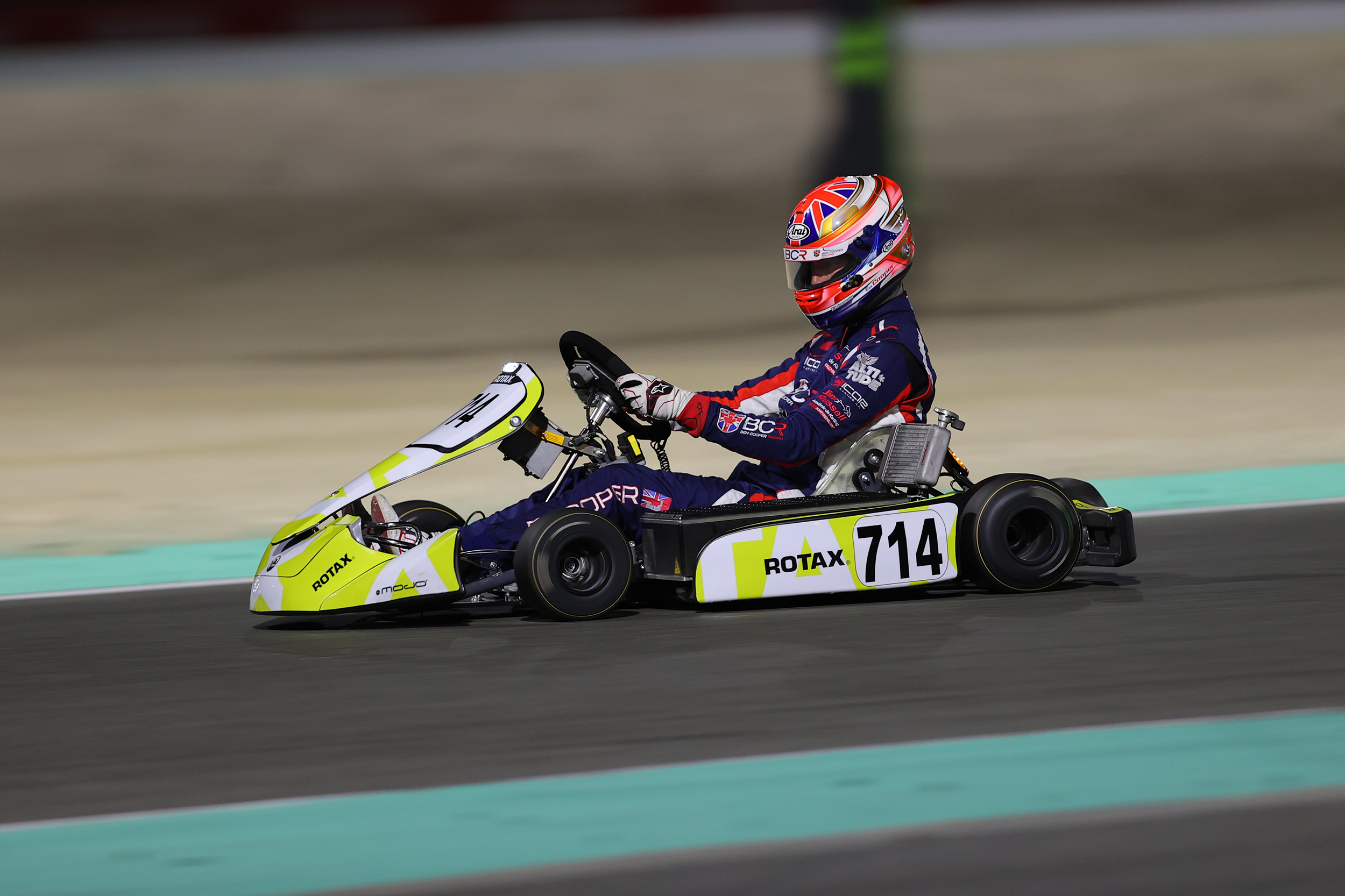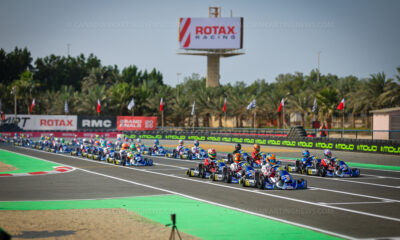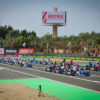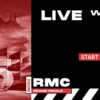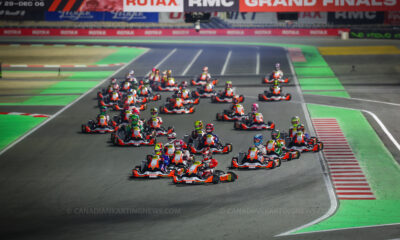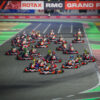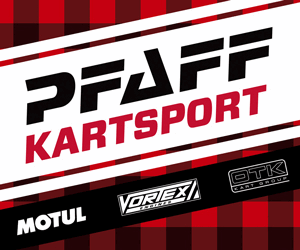Driver Blogs
Ben Cooper: Are electric karts the future?
Ben Cooper trials the Rotax E20 in Bahrain and recaps his thoughts for CKN
This I believe is the question that many people ask themselves when they see Rotax’s E20 karts racing around at the Rotax Max Challenge Grand Finals (RMCGF). This is the third time that we have seen electric karts participate at the RMCGF’s, but the significance this time is that it is now an official category, not a demonstration or part of the DEKM like the previous years in Brazil and Italy.
In 2017, at the RMCGF in Portimao, Rotax introduced the Rotax Thunder, which was the first variant of the electric kart. Rotax had partnered with an Italian company to produce this “prototype” and I had the chance to give it a go. Five years later, this past Saturday night, after the finals of this year’s RMCGF in Bahrain, Pier Luc Oullette (PLO) and I got a chance to have a go on Rotax’s latest E KART, the ‘Project E20’.
Now the Project E20 is fully made in-house by Rotax, but it has not been changed technically since its design in 4 years. This does not mean that Rotax is not developing its product. Led by Steven Chapman, this project is advancing as quickly as the technology allows. The 20 karts have been running for the last 3 years with little to no maintenance. Racing in the German DKM series under the name DEKM for the past 4 years as well as a select few races of this year’s Rotax Euro Trophy, Steven and Rotax have been learning and developing their product.
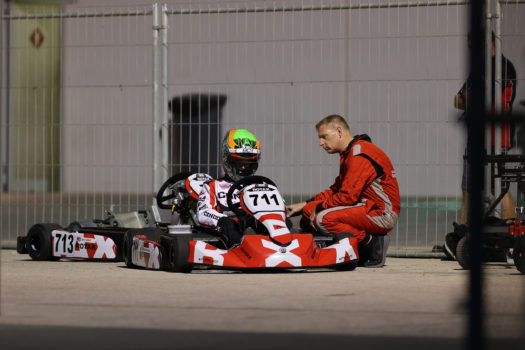
The current karts have a charge that lasts around 12.5 minutes on track (depending on track demands) and can be recharged within 40 to 45 minutes. Not bad considering at most race events, competitors are on track for 10 minutes practice sessions, then have a minimum of 1 hour to wait before their next session. Weighing around the 200kg mark with the driver, the kart is obviously heavy, with this being a big factor in the kart’s drivability.
As mentioned above, the karts have not been touched in four years. With the exception of a single oil change in the electric motor (after 240 hours of use) and a new Sodi kart chassis prior to this weekend’s RMCGF. The karts have been pushed through thousands of hours on the track and the batteries have been through 1300 charging cycles. With all that being said, the batteries have lost 0.01% of their charge capacity during that time. Impressive if you compare to the traditional maintenance of its combustion engine counterparts.
Now let’s get to the part everyone wants to hear. What’s it like on the track? As I said, I got to drive the first version, the Thunder back in 2017. My first impression of that was that it was fast off the line, but it was very heavy. Braking distances were long, and you could feel the weight through the steering wheel. But the thing that stuck with me was that instant power. Let’s not forget its overtake button. This feature is ever-present on the E20. The original Thunder version had a lap time that would fit between a Mini Max and Junior Max depending on the track and around 7 mins of run time with 5 seconds of boost every 30 seconds for the 50% of the battery life.
Now the E20 lap times slot in between Rotax Senior and DD2, however in Bahrain due to the fixed gearing of the Project E20, the Project E20 was slightly slower than Senior due to the nature of the track being very fast and flowing, meaning the Project E20 couldn’t exploit its power advantage across its normal RPM range.
Now the E20 lap times slot in between Rotax Senior and DD2
Saturday night, after the podium ceremony, PLO and I went to see Chapman to get our safety briefing so we knew how to start the karts. It’s a very simple process. Push the key fob in, press the on/off button, which is all situated under the steering wheel, where the gas tank is normally located. Once the on/off button is pushed, the AIM Mychron MXM specially designed for the E20, turns itself on, and then you follow the instructions. Initially, it tells you to wait, while the system goes through all of its checks, which takes roughly 10 seconds, then the dash tells you to press the brake and both buttons on the steering wheel to engage drive. Then you’re ready to go. Oh, I did say both buttons on the steering wheel, 1 being the boost button, and the other being reverse.
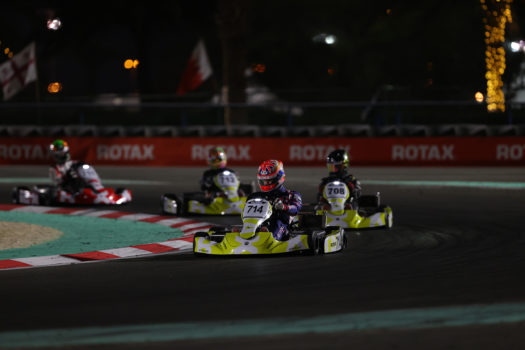
Displayed on the dash, is the usual, speed, lap time, power, and battery percentage. 100% to 0% is displayed on the dash, but this in reality is 95% to 30%. This allows for the batteries not to be pushed too far and allows for a safe range in case you do hit the displayed 0%. This way you can still drive it back to the pits.
The only major safety precaution to look out for is displayed on the dash. If the 2 top lights are red, then there is an error and it’s best to stay in the kart, or if you want to get out, you have to stand in the seat and then jump out without touching the kart, as there may be an electrical fault making the kart live. As Chapman said, in 3 years they have never seen this happen, which means their safety systems are working.
So there we were, PLO and I, sitting on the grid with a few other drivers who had been racing the E20 during the week. Our main purpose was to help with filming for a promotional video Rotax was producing. Now I have driven everything when it comes to karts, Rotax, Briggs, historic karts, KZ, ICA, Formula A and the original Rotax Thunder. But I can honestly say there is nothing I have driven that made me feel like the E20 when it took off the line. Not even a Porsche 911 Turbo using launch control. The best way I can describe it is like a rollercoaster when you go over that first big drop and your stomach stays at the top.
WOW, the thing moves with its 20kw power output.
So off we went, on cold tires out of the pits, wheel spinning for at least 10 to 20 feet. It’s a rocket, so much so that PLO let out a scream of excitement as he took off in front of me. And yes I could hear him, it’s an electric kart, there’s no noise, with the exception of tire noise and the quiet zip from the motor. As we headed into the first corner out of the pits, PLO slowed and looked over his shoulder to see if I was still there. All I could see through his clear visor were the bold whites of his eyes demonstrating his shock at the raw speed of the E20’s acceleration. I’m sure I had the same expression.
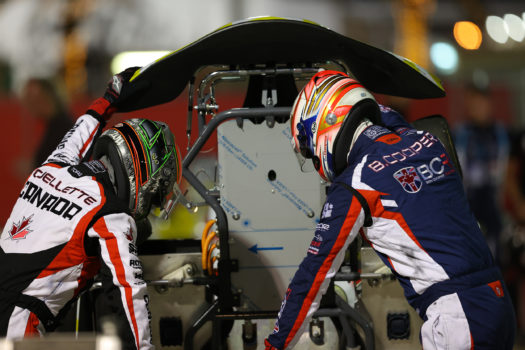
Off we went on the first of 2 laps with the camera kart chasing us. We had to make it look racey, which was very easy. There are 3 things that take you back when your driving, firstly as mentioned, its acceleration, its phenomenal, secondly, the sound of the tires, wow, you can hear everything about them, it’s like their talking to you, telling you that you’re going too fast for them, overloading them, and thirdly, the aggressive noise of the exit curbs, the deafening vibration. Oh and I forgot the fourth thing, the chassis hitting the ground. That takes some getting used to because it’s not a nice sound. After the first 2 laps were completed in the pits we went and after the initial excitement, you take it all in. Then it hit me, with the exception of its speed, all the other things I mentioned are normal when you’re driving, except you can’t hear them over the noise of the engine normally.
You can hear the tires normally, but not in that detail, you can feel the curbs, not hear them, and you can only ever hear the chassis hitting the floor when you’re jumping the curbs. These sensations add a whole other level to the driving experience.
As the night proceeded, we were on and off the track throughout the next hour or so, pushing our limits when we could. PLO going over the limits with a spin while pushing the braking to the max, he won’t like me saying that, but hey, he only finished second so it’s fine. Side note, what a story he has gone through and I am sure that all of us across karting in Canada are proud of him and are pushing him to come back next year to move up that #1 spot that he deserves.
We were told before driving, not to press the boost button to save the battery for the filming. Naturally, what did we immediately do? Press the boost button. And my word it gives you a kick up the backside. It gives you an extra 4kw of power for 5 seconds and then takes 30 seconds to recharge. These things are fast, somewhere between DD2 and KZ fast, but when the boost button is pushed, we are talking easily KZ speeds down the straight. That’s with the karts weighing 200kg with the driver. Imagine in the future when technology allows the weight to be reduced.
Now let’s get to the negatives, and there is only one. Obviously, it’s the weight.
Now the difference since my first experience with the Thunder is that the E20 didn’t feel heavy through the steering wheel anymore, Rotax has carefully placed to the components to ensure good weight distribution for a real karting experience. It felt just like a DD2 when I was driving. You feel the weight through the brakes. It makes the braking uncertain. You’re not too sure where your braking zone is as the weight makes the kart feel numb under braking. This will all get better with time and I believe that with more laps you would adapt as a driver, so much so that it would become the norm.
Let’s talk about the developments. As I said, these karts have not been touched in four years, but this doesn’t mean that development has not been taking place. Chapman explained that if they were to want to use the updated version of the E20 in a racing environment like now, they would have to go through all of the EU safety tests and procedures for each upgrade. This process costs Rotax north of half a million Euros and nine months of work. Therefore all the developments are taking place in a controlled testing environment.
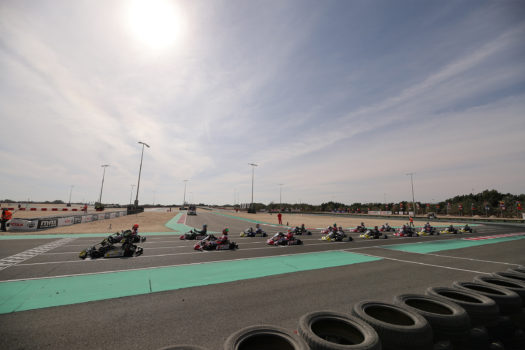
Over the course of the last 4 years, they already have dropped 15kg off the karts, which relates to roughly 1.5 seconds quicker on track, taking it past DD2 pace. The batteries have 20% more capacity. The charging time is being reduced yearly. A bolt-on Cadet engine has been produced and there are plans for an E20 Junior category next year. All of this has been done during a time in which over the past 2 years Covid has disrupted millions of businesses around the world, Rotax being one of them. Think where this product could be in the next 5 years, which is when Rotax aims to start making this a product that goes from being a “prototype” to a sellable item. There are no prices being spoken about yet, but I believe their goal would be in a DD2 kart price range, which would be impressive considering the lack of maintenance cost involved.
The next question is the charging process, which will take some time to perfect. In Europe now they are developing mobile charging stations, solar power charging stations. So they are working on solutions. Just like in the automotive industry, the questions are the same, and solutions are being found. This will take time and time only.
Here’s the final question, is this the future of karting? Now I don’t have an answer to that, and I don’t think anyone will have that answer. I believe that the answer to that question will be decided by world culture. We are seeing a push for electric vehicles all over the world right now, with all manufacturers developing their own tech. Now is this because they have to, especially in the EU due to the new laws imposed on them, or is it because they truly believe in it or are the future biofuels? Only time will tell.
Many people will have their opinions, negative or positive, but I truly believe that there will be a market for E Karts. There will be generations that will grow up with just electric cars, which will be all they know. There will be hobby drivers, that won’t want to deal with mixing fuel, rebuilding engines, that will just want to show up, have their batteries charged and get on track, “Plug and Play” as Rotax likes to say. I see this change being very similar to when karting went from direct drive engines to TAG (touch and go) engines. I lived through this change and there were many skeptics back then just as there will be now. But one thing that hasn’t changed since then, was that Rotax was at the forefront of TAG engines, just as they are now at the forefront of E Karts.



